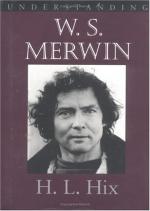|
This section contains 7,111 words (approx. 24 pages at 300 words per page) |

|
SOURCE: Clifton, Michael. “Breaking the Glass: A Pattern of Visionary Imagery in W. S. Merwin.” Chicago Review 36, no. 1 (1988): 65-83.
In the following essay, Clifton explores Merwin's visionary poetry—poetry that deals with altered states of consciousness—written between 1962 and 1977, asserting that it exhibits a progression from a negative to a positive vision and a coming-to-terms with the unconscious and death.
After quoting Blake's own words to establish his work as essentially “‘Visionary,’” and then defining that term as the “view of the world … as it really is when it is seen by human consciousness at its greatest height and intensity” (143), Northrop Frye suggests an important but largely ignored point for criticism in his essay “Blake After Two Centuries” when he observes that works like Aldous Huxley's The Doors of Perception “seem to show that the formal principles of this heightened vision are constantly latent in the mind,” and...
|
This section contains 7,111 words (approx. 24 pages at 300 words per page) |

|


